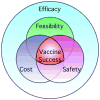Contributions of humoral and cellular immunity to vaccine-induced protection in humans
- PMID: 21216425
- PMCID: PMC3238379
- DOI: 10.1016/j.virol.2010.12.016
Contributions of humoral and cellular immunity to vaccine-induced protection in humans
Abstract
Vaccines play a vital role in protecting the host against infectious disease. The most effective licensed vaccines elicit long-term antigen-specific antibody responses by plasma cells in addition to the development of persisting T cell and B cell memory. The relative contributions of these different immune cell subsets are context-dependent and vary depending on the attributes of the vaccine (i.e., live/attenuated, inactivated, and subunit) as well as the biology of the pathogen in question. For relatively simple vaccines against bacterial antigens (e.g., tetanus toxin) or invariant viruses, the immunological correlates of protection are well-characterized. For more complex vaccines against viruses, especially those that mutate or cause latent infections, it is more difficult to define the specific correlates of immunity. This often requires observational/natural history studies, clinical trials, or experimental evaluation in relevant animal models in order for immunological correlates to be determined or extrapolated. In this review, we will discuss the relative contributions of virus-specific T cell and B cell responses to vaccine-mediated protection against disease.
Copyright © 2010 Elsevier Inc. All rights reserved.
Conflict of interest statement
These potential conflicts of interest have been reviewed and managed by OHSU and the Integrity Program Oversight Council.
Figures

References
Publication types
MeSH terms
Substances
Grants and funding
LinkOut - more resources
Full Text Sources
Other Literature Sources

